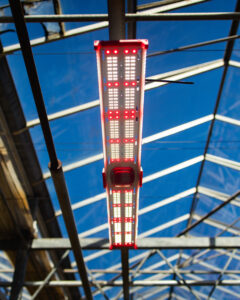
June 20, 2025
If you’ve been growing cannabis for a while — or you’re diving into your first serious indoor run — you’ve probably heard the term VPD tossed around. At first, it sounds like just another metric, but here’s the truth:
Dialing in your VPD can be the difference between having plants that struggle and plants that thrive.
I’m going to break it down in plain English and share what we’ve learned from trial and error with our customers here at JumpLights.
What Is VPD?
VPD stands for Vapor Pressure Deficit, and it’s a measurement of how hungry the air is for moisture – how much available water it can hold.
Think of it like this:
- When the air is dry (low humidity), it pulls moisture from your plants faster.
- When the air is humid (high humidity), it slows down how much moisture your plants release.
VPD is the pressure difference between the water inside your plant’s leaves and the water in the air around them. It directly affects transpiration (how plants “breathe” and move water/nutrients around).
Why VPD Matters in Cannabis Cultivation
Here’s why growers, especially indoor cultivators, should care about VPD:
1. Nutrient Uptake Depends on It
When VPD is too low (humid and cool), plants don’t transpire much. That means slower water and nutrient movement, which can cause deficiencies like calcium or magnesium even if they’re in your feed.
2. Growth Speed and Stomatal Activity
The stomata (those little pores on your leaves) react to VPD. With the right VPD, they stay open, allowing the plant to photosynthesize, grow, and stay healthy.
3. Prevent Mold and Mildew
If your VPD is too low during flower, you’re asking for trouble. Botrytis (bud rot) and powdery mildew love wet, stagnant air.
4. Stress and Recovery
Dialing in VPD helps your plants handle stress better like after a transplant, pruning, or LST.

Ideal VPD Ranges for Cannabis
Use a VPD chart or calculator to get exact values based on leaf temperature and relative humidity (RH), but here’s a simple breakdown:
| Stage | Temp (°F) | RH (%) | Target VPD (kPa) |
| Clones | 75–78 | 70–80 | 0.4–0.8 |
| Veg | 78–82 | 55–70 | 0.8–1.2 |
| Early Flower | 78–80 | 50–60 | 1.0–1.3 |
| Late Flower | 75–78 | 40–50 | 1.2–1.6 |
Pro tip: Measure leaf surface temp with an IR thermometer. VPD calculators are way more accurate when you plug that in instead of air temp.
Signs Your VPD Is Off
Too Low VPD (Too Humid / Cool)
- Droopy leaves
- Nutrient deficiencies (especially Ca/Mg)
- Mold or mildew risk
- Slow growth
Too High VPD (Too Dry / Hot)
- Leaf tip burn
- Plants drinking too fast
- Wilting or leaf curling
- Stunted development
How to Fix VPD Issues
If you’re off-target, don’t worry. You can adjust things pretty quickly.
If VPD Is Too Low (Too Humid):
- Increase temps: A 2–3°F bump can raise VPD noticeably.
- Add more airflow: Circulation helps dry the air around the canopy.
- Use a dehumidifier: Especially in flower, this is key.
- Reduce watering frequency: Let roots breathe more between feedings.
If VPD Is Too High (Too Dry):
- Lower your temps slightly to help reduce transpiration.
- Add a humidifier: Especially in veg or clone stages.
- Raise your lights or dim them: High-intensity light raises leaf temp.
- Mist clones or seedlings more frequently to protect soft tissue.
Remember: Temperature and humidity work together. Changing one always affects the other when it comes to VPD.
Tools That Help
- Pulse Monitor / SensorPush / Growlink: VPD calculators + alerts
- IR thermometer: Get leaf surface temps easily
- VPD chart taped to the wall: Trust me, it helps during watering or checks
Final Thoughts
Many growers we work with at JumpLights focus on feeding schedules, lighting, and airflow and while those are huge, they don’t realize they may have had the wrong environment for their plants. Once these growers locked in VPD, everything changed: Healthier plants, better yields, fewer problems, and way less stress.
So if you’re not tracking VPD yet, now’s the time. It’s not about being a perfectionist; it’s about giving your plants what they need to thrive.
And that’s the whole point, right?





